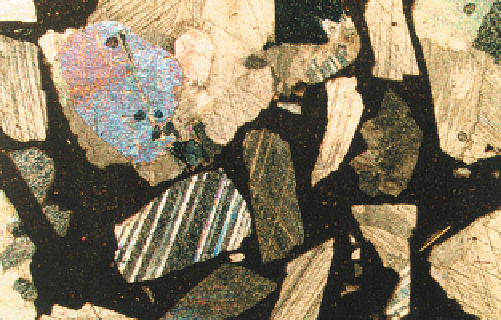Geoscience Reference
In-Depth Information
Granolithic screed is essentially concrete which contains
granite or other suitable crushed rock aggregate, to
provide wear resistance. Figure
260
shows the 'concrete-
like' appearance of a granolithic screed consisting of
granite coarse aggregate and natural sand fine aggregate,
bound by a Portland cement matrix; the screed exhibits
typical good compaction with very few air voids present.
Granolithic screeds usually provide durable floor finishes
but problems do occasionally occur. These typically
involve drying shrinkage cracking as granolithic screeds
are normally cement-rich and can have a high water
demand. Other defects may involve debonding and/or
curling of the screed, due to drying shrinkage and
possibly inadequate preparation of the base.
similar mixes to
in situ
terrazzo, but they are precast in
factories under controlled conditions and are now generally
preferred owing to their assured quality. Tile thickness
varies depending on the plan size with a common tile size
being 300 × 300 × 28 mm. The tile thickness may include
a nondecorative (and cheaper) backing mix.
In thin section, terrazzo typically has the appearance of
fine aggregate-deficient and cement-rich concrete
(cement:aggregate ratio typically 1:2.5-3.0). The cement
type is often white Portland cement and may include a
considerable quantity of pigment. Owing to the high
cement content it is relatively common to observe some
degree of microcracking of the cement matrix. Figure
261
shows the appearance of a cast
in situ
terrazzo consisting
of marble chips bound by white Portland cement. The fine
detail of the uncarbonated cement matrix is obscured by
the presence of pigment. Figure
262
shows a terrazzo floor
tile consisting of polishable crushed limestone coarse
aggregate and crushed decorative marble fine aggregate,
bound by a white Portland cement matrix. Again, the
detail of the uncarbonated cement matrix is obscured by
the presence of pigment and also a certain amount of
calcium carbonate dust.
Providing that it is correctly formulated, laid, and
maintained, terrazzo can provide a relatively hard and
durable floor surfacing. Some of the most common terrazzo
defects involve unsightly macrocracking that runs
perpendicular to the upper surface.
In situ
terrazzo is
Terrazzo is a special form of decorative concrete floor
finish that uses coloured cement (often white) and
decorative aggregate such as marble chips. The surface is
ground to expose the aggregate, which has a great
influence on the appearance.
Terrazzo may be laid
in situ
or, more commonly, as
terrazzo tiles.
In situ
terrazzo is normally laid on a high-
quality screed while the screed is still 'green', to a thickness
of not less than 15 mm. Once laid, coarse surface grinding
is undertaken after about 4 days, then filling and fine
grinding after a further 3 days. Terrazzo tiles consist of
260
261
260
Granolithic screed with crushed granite coarse
aggregate (upper left) and natural sand fine aggregate,
bound by an uncarbonated matrix of Portland-type
cement (black with brightly coloured 'specks'
comprising portlandite crystallites). Well compacted
with no air voids visible; XPT, ×35.
261
In situterrazzo floor finish, comprising crushed
marble chips (pink/light brown) bound by an
uncarbonated matrix of pigmented, white Portland
cement (dark brown); XPT, ×35.






